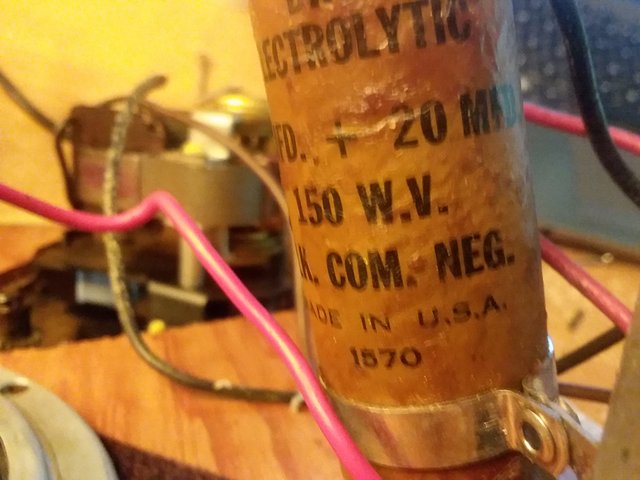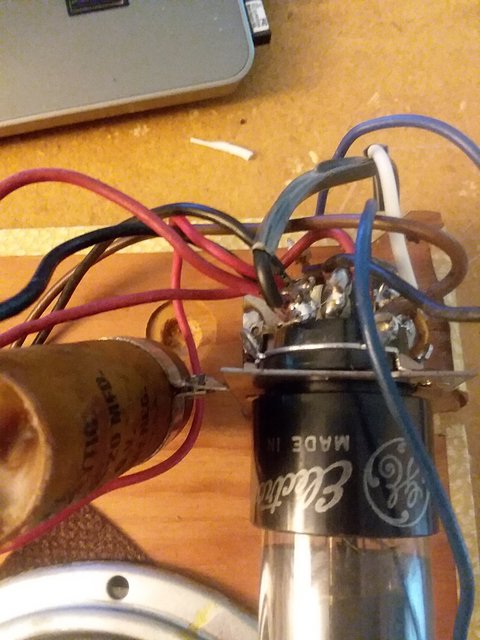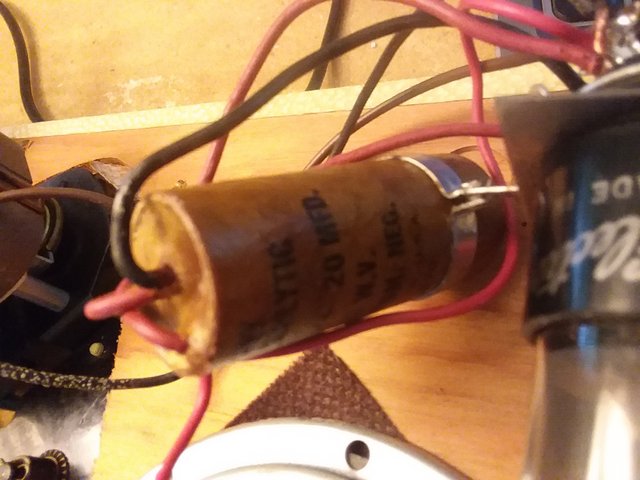Do I have to replace this with one of the canister type, or will a modern one like this on ebay work, or where can I source a cheap replacement?
CNH 7435 20 MFD 150WV 20-150 Capacitor *FREE SHIPPING* | eBay
Much appreciate any help. I have this little old phonograph like what you would have see in schools or for kids maybe in the 60s. Tube lights up and it makes that capacitor hum.



CNH 7435 20 MFD 150WV 20-150 Capacitor *FREE SHIPPING* | eBay
Much appreciate any help. I have this little old phonograph like what you would have see in schools or for kids maybe in the 60s. Tube lights up and it makes that capacitor hum.



I can nearly see 20+20 uF, thus 2 caps is needed. My guess at least 300Volt.
Is there 3 wires connected to it ?
What voltage is across the cap when powered on ?
Is there 3 wires connected to it ?
What voltage is across the cap when powered on ?
Okay thanks, I didn't notice "20 + 20" -- I'm totally unfamiliar with these circuits so I'm asking as a noob.
Yes it has three leads (it says "BLK COM NEG) on the capacitor itself that are all wired to the single 117 N7 GT tube. Also has 7-52 188-5 on the black part of the tube (backplate type?).


Yes it has three leads (it says "BLK COM NEG) on the capacitor itself that are all wired to the single 117 N7 GT tube. Also has 7-52 188-5 on the black part of the tube (backplate type?).


I found description of the tube and a possible schematics :
117N7GT, Tube 117N7GT; Rohre 117N7GT ID5807, HalfWave Rectif
117N7GT, Tube 117N7GT; Rohre 117N7GT ID5807, HalfWave Rectif
That OEM part is clearly marked 150 working volts. As modern electrolytic caps. are much more volumetrically efficient, use 200 WVDC or even higher rated parts and increase the operating margin. 2X of this part will satisfactorily replace what's currently present. Stick 'em down with hot melt glue.
The 117N7 is 2 devices in a single envelope. The envelope contains a 1/2 wave rectifier (single diode) and a beam power tetrode. That sort of stuff was used in the cheapest equipment. Almost certainly, that phonograph does not contain a power transformer. As such, it is unsafe and does not comply with current codes.
The 117N7 is 2 devices in a single envelope. The envelope contains a 1/2 wave rectifier (single diode) and a beam power tetrode. That sort of stuff was used in the cheapest equipment. Almost certainly, that phonograph does not contain a power transformer. As such, it is unsafe and does not comply with current codes.

If you are working with this "live chassis" device which does not have a power transformer our rules require the acknowledgment of need for and use of an isolation transformer in order for the discussion to be able to continue here.
Please confirm you understand and will comply with the requirement.
Thanks!
In cases where the cap is inside the chassis I usually zip tie two caps together. Definitely get higher rated caps like 250v. Line voltages are higher than they used to be.
If you're wondering why the cap suggested by Eli is so much cheaper than the other one that was linked (62 cents vs $2.50), it's because caps with axial leads (one coming out each end) are much more expensive than radial leads (both coming out the same end) and 20uf is not as common a value today as 22uf. Either one will work fine. The cheaper one is actually a better cap too since it's rated for 10,000 hours vs 2000 for the more expensive one.
However, if you order from Mouser, shipping charges will cost several times more than the caps.
But another major supplier, Digi-Key, sells the same caps and they offer a free shipping option.
Many people are not aware of this because it's hidden in the fine print under Terms & Conditions at the bottom of their webpage. Details are in this thread that I posted on another forum:
Free Shipping On Parts Orders | Audiokarma Home Audio Stereo Discussion Forums
However, if you order from Mouser, shipping charges will cost several times more than the caps.
But another major supplier, Digi-Key, sells the same caps and they offer a free shipping option.
Many people are not aware of this because it's hidden in the fine print under Terms & Conditions at the bottom of their webpage. Details are in this thread that I posted on another forum:
Free Shipping On Parts Orders | Audiokarma Home Audio Stereo Discussion Forums
Kevin -- Thank you for that - yes I understand and respect the requirement.
If you are working with this "live chassis" device which does not have a power transformer our rules require the acknowledgment of need for and use of an isolation transformer in order for the discussion to be able to continue here.
Please confirm you understand and will comply with the requirement.
Thanks!
A pair of these will work fine:
30D206G160DF2A Vishay | Mouser
I found description of the tube and a possible schematics :
117N7GT, Tube 117N7GT; Rohre 117N7GT ID5807, HalfWave Rectif
But another major supplier, Digi-Key, sells the same caps and they offer a free shipping option.
Thanks all, very much. That's great that the schematic is available. Just opened it up to look at it, haven't actually touched it. Will get together an order for some stuff for other SS projects and put that in with Mouser or Digikey. Much appreciate all the tips. It's not such an interesting device in itself, I just found it interesting that such a cheap and small device from that time has a tube circuit tucked inside - would normally be overlooked. I guess it may be from the 50s.
Way back then, only tubes were available and nothing else, so ....I just found it interesting that such a cheap and small device from that time has a tube circuit tucked inside
Yeah a little before my time 😎 but I figured transistor radios were common in the 50s, but some things like this were probably still tube until...
szegedin,
The transistor was first demonstrated by 3 inventors at Bell Labs in 1948.
The transistor radios were not common until the late 50s (just starting to replace things like 4-tube 2-battery portable radios).
The girls of the time said: "I love my 'transistor'", which actually was their miniaturized 9V battery powered 6 transistor radio (plus all those other parts too).
The best I could do in 1958 was get my hands on a pair of Raytheon Germanium CK722 PNP transistors. DC and sort-of Audio only.
You could purchase those little 6 transistors easily, but getting transistors for experimentation was so much harder than getting tubes and solid state diodes.
In 1959, a world record distance was set (versus power output). The distance was 13,500 miles the long way around the world (beam antennas pointed the longer distance way).
Those were Philco Surface Barrier transistors working at 30MHz.
I did a close examination of the Jan-Feb 1956 issue of "Hi-Fi Music at Home" with the cover title "1956 the complete guide to HI - FI MUSIC from RECORDS TAPE & RADIO".
68 pages, with lots of advertisements did not show a single mention of a Transistor.
The transistor was first demonstrated by 3 inventors at Bell Labs in 1948.
The transistor radios were not common until the late 50s (just starting to replace things like 4-tube 2-battery portable radios).
The girls of the time said: "I love my 'transistor'", which actually was their miniaturized 9V battery powered 6 transistor radio (plus all those other parts too).
The best I could do in 1958 was get my hands on a pair of Raytheon Germanium CK722 PNP transistors. DC and sort-of Audio only.
You could purchase those little 6 transistors easily, but getting transistors for experimentation was so much harder than getting tubes and solid state diodes.
In 1959, a world record distance was set (versus power output). The distance was 13,500 miles the long way around the world (beam antennas pointed the longer distance way).
Those were Philco Surface Barrier transistors working at 30MHz.
I did a close examination of the Jan-Feb 1956 issue of "Hi-Fi Music at Home" with the cover title "1956 the complete guide to HI - FI MUSIC from RECORDS TAPE & RADIO".
68 pages, with lots of advertisements did not show a single mention of a Transistor.
Last edited:
The moderators will correct me if I'm inaccurate. To comply with forum rules, the electronics must be isolated from the AC mains. However, I think the rules allow for the turntable's motor to remain unisolated. That motor represents the bulk of mains current drawn. If possible provide that motor's draw.
Given the above, a Triad N-68X isolation transformer is a low cost solution to rules compliance.
Given the above, a Triad N-68X isolation transformer is a low cost solution to rules compliance.
- Home
- Amplifiers
- Tubes / Valves
- Replace cap for little old phonograph